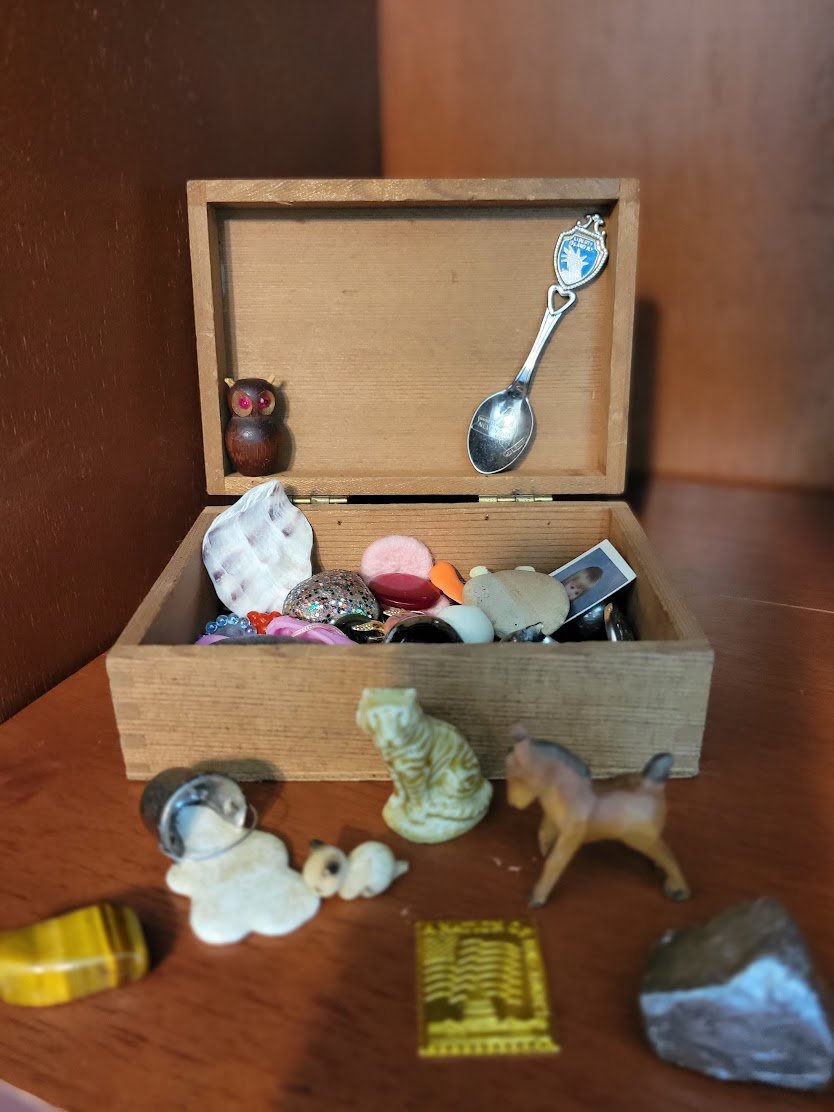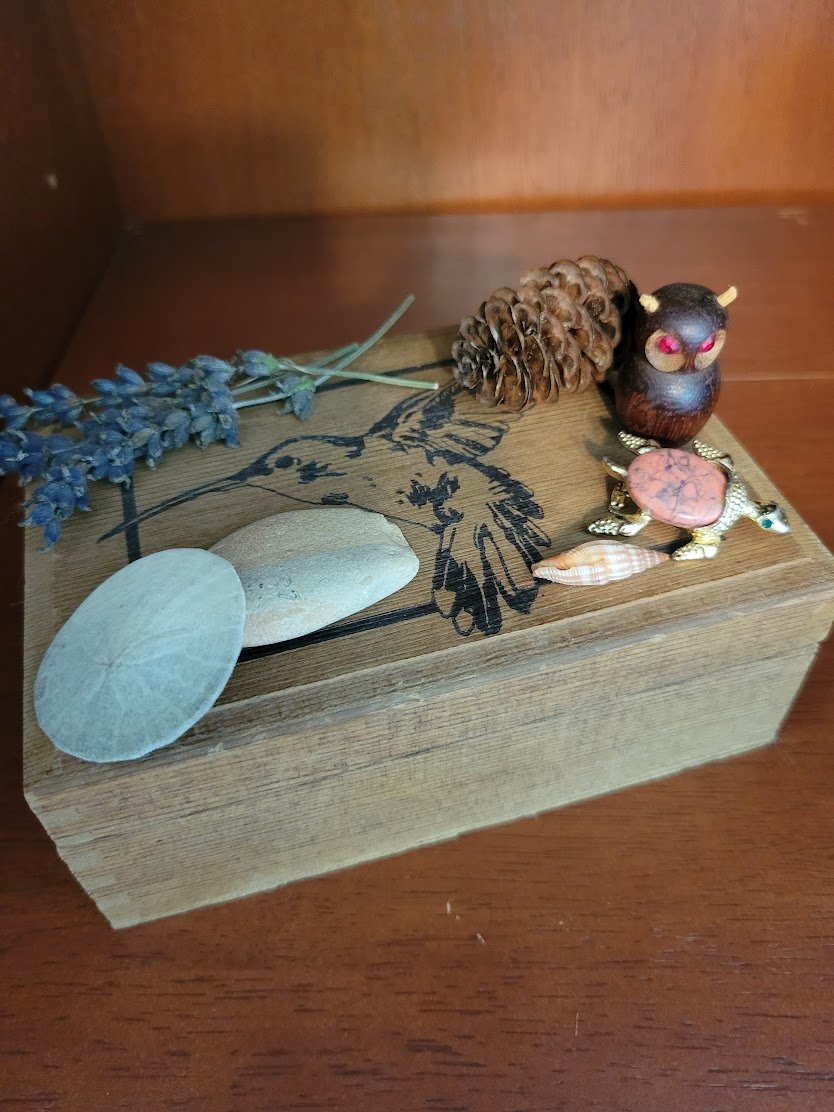Solid Objects: Sarah Fawn Montgomery
Tayari Jones keeps a baby food jar of dirt on her desk from Toni Morrison’s hometown. CJ Hauser gifts her students a tiny plastic chicken to pull out whenever and wherever it’s time to write. Writing totems, talismans, amulets—we ascribe many names to the objects we keep close while we write. These objects inspire us, comfort us; they can prompt our productivity, make their way into our writing, or at the very least, serve as a dangling carrot to the world beyond our daily pages.
In Virginia Woolf’s short story, “Solid Objects” her main character grows enamored with a smooth piece of green glass he finds at the beach. “It pleased him; it puzzled him; it was so hard, so concentrated, so definite an object compared with the vague sea and the hazy shore.” The right object can be our own green glass; a raft when we’re treading the slippery shapes thoughts take.
In SOLID OBJECTS, we ask writers about the objects most essential to their creative practice, and what exactly these objects do for their brains.
This edition is written by Sarah Fawn Montgomery. Her essay collection Halfway From Home is forthcoming from Split/Lip Press in November. You can preorder it here. You can also read her work in Issue 70, out now.
No one’s ever accused me of being sentimental. A notorious cynic, nomad, and someone for whom clutter crowds the mind, I’m the first to discard items others might cherish. I’ve gotten rid of yearbooks and cards, journals and loved books. I’ve parted with family furniture and knick-knacks, sometimes, admittedly, even a few friends. People in my life laugh when I cannot recall moments we’ve shared, because recollecting is how I make my living and I have the unfortunate tendency of sometimes getting rid of memories that do not serve me. As a memoirist, I revisit the past time and again, and yet I do not own a single object from my childhood.
Except one. My treasure box is a collection I began before I could tie my shoes or tell time. It is a curation handed down as if by magic.
I discovered my treasure hole when I was four or five, a shallow hollow in my backyard filled with polished stones and marbles, ceramic figures and wooden animals. Who left the treasure? I wondered. Where had these people gone? What and who and how had they loved? Dusting off the objects, I created stories around them before tucking them inside a tiny wooden box.
The joy I felt as a child digging beneath the surface is why I am an essayist. I’ve long made meaning by uncovering what has been hidden—by time, by chance, by trauma—in order to tell a story. I’ve made a life unearthing, unburying, and I’ve written a narrative for myself where I am always digging, always discovering.
I get this impulse from my father, who gave me the hidden treasures those many years ago. A fence builder, my father spent his life digging holes, excavating the land to create the borders and boundaries that made the world make sense. He loved uncovering things and found most of the objects he later buried for me on job sites. There were old nails and rags and rusted pennies, but the treasures—a tiny silver spoon, a yellow ceramic tiger, a metallic stone—he saved for me. He gave me these trinkets and the thrill of pulling them from the ground and thinking myself lucky and clever. And then he gave me his attention as I told him about what I’d found and the imaginary worlds they might have come from. In many ways, my father gave me the art of storytelling.
I keep this collection, this careful child’s creation, in my office to remind me that storytelling is a gift. I don’t mean that it is a talent we are born with, but rather that it is an act of curiosity that we can give ourselves. Too often we find ourselves too busy to write because we are too busy for wonder. This collection also reminds me that anyone can be a storyteller—a young girl muddy and elated, a man digging holes to fill with cement. It reminds me that anything can be a story—a gray rock, a scratched button. It reminds me that the past is a treasure trove, a place to uncover, to discover time and again. It reminds me that there are stories all around and underfoot if only we stop to notice and take the time to dust them off and put them on display.
I’ve written about my childhood and my father, even about my treasure box and tiny artifacts. First published in Bellingham Review, my essay, “Excavation,” explores my childhood fascination with digging, my relationship with my father, and the complex ways uncovering and burial shape my emotional and environmental worlds. This essay opens my latest collection, Halfway from Home, which blends lyric memoir with lamenting cultural critique, examining contemporary longing and nostalgia, searching for how to build a home when human connection is disappearing, and how to live meaningfully when our sense of self is uncertain in a fractured world. When I struggled to write, opening the treasure box brought me back in time, reviving memory and curiosity to help guide the story.
I’ve carried the importance of digging and the bounty of my youth across many homes and the country, across many years and into adulthood. I’ve added a few things too—cat whiskers and puppy teeth from all the creatures I’ve loved, a beautiful shell with purple markings that I’ve never found on another since, a key to some life I’ve forgotten. Now when I open the box, the hinge creaks with age.
My father is gone. A recent loss. I miss him terribly and fear, that like I am wont to do, I will start to declutter my mind of the memories of him that cause me pain, even those that do so with their sweetness. I am afraid I will lose these important artifacts of our lifetime together. I am trying to write them down before they are gone, but it is hard.
When I am too much with the world and find it too difficult to write, I open the box to remind myself how to discover magic. I palm pebbles and smooth shells. I smell dried lavender and beach sand. I go back in time to when my father was alive, to when we dug holes together in order to discover possibility, to when storytelling was as simple as reaching my hand into the earth and grasping.
Sarah Fawn Montgomery is the author of Halfway from Home (Split/Lip Press), Quite Mad: An American Pharma Memoir (The Ohio State University Press), and three poetry chapbooks. She is an Assistant Professor at Bridgewater State University. You can follow her on Twitter at @SF_Montgomery.




